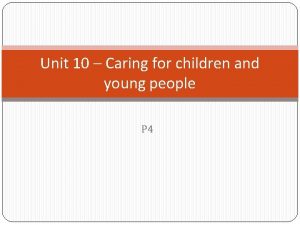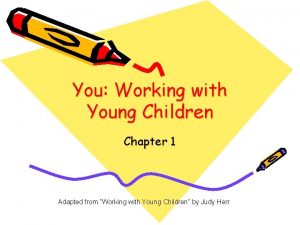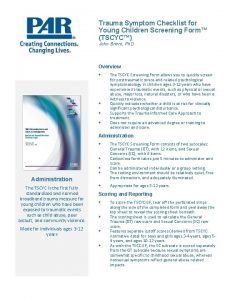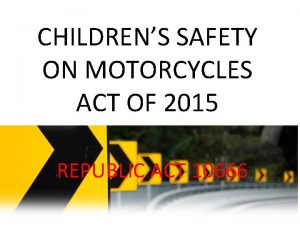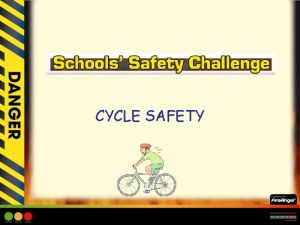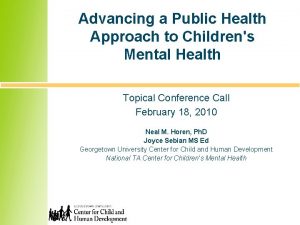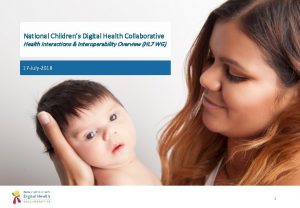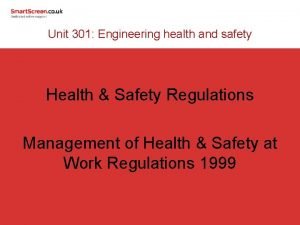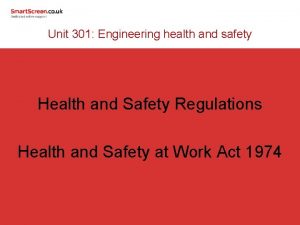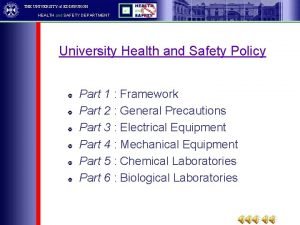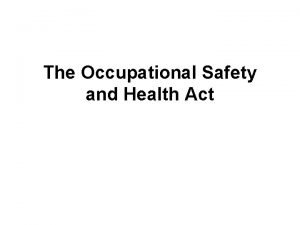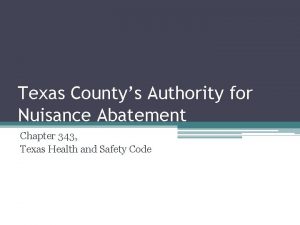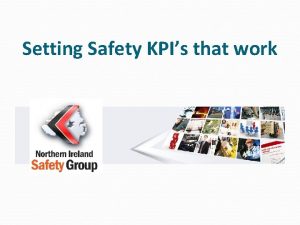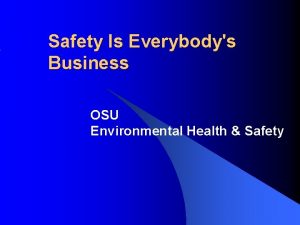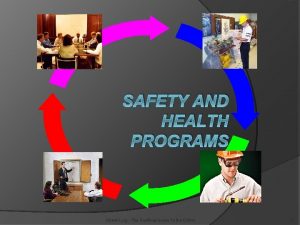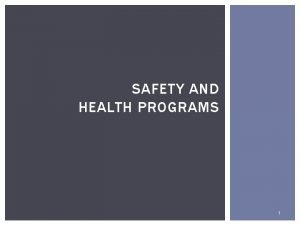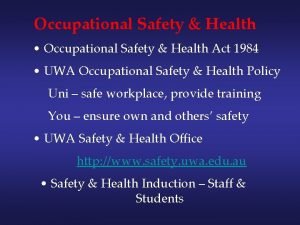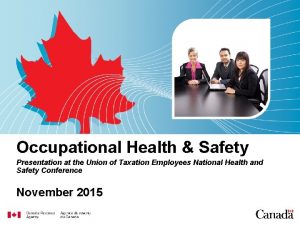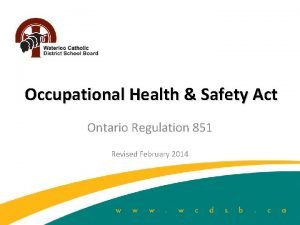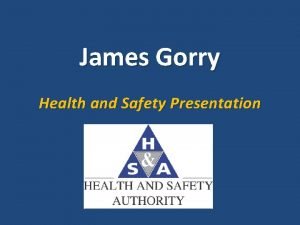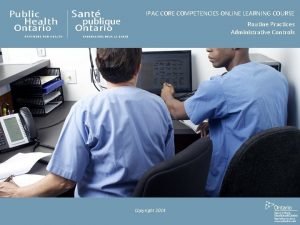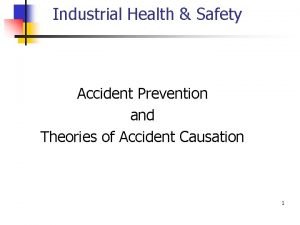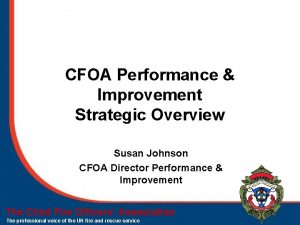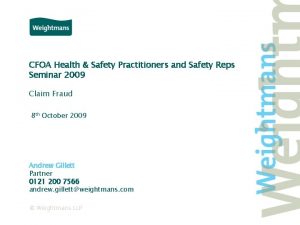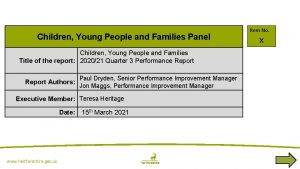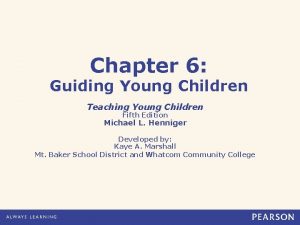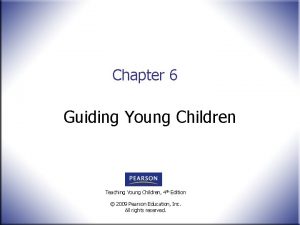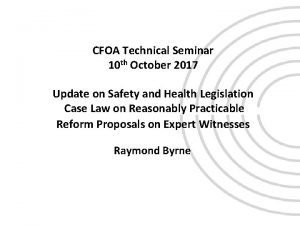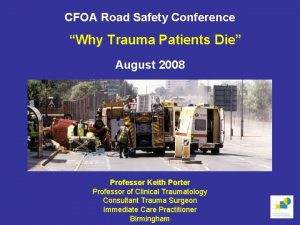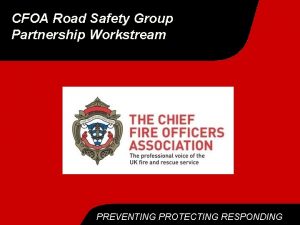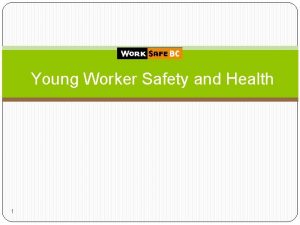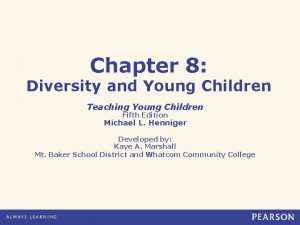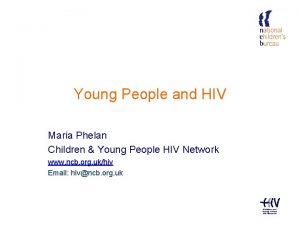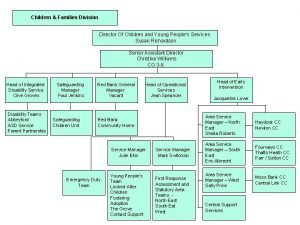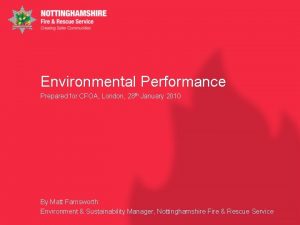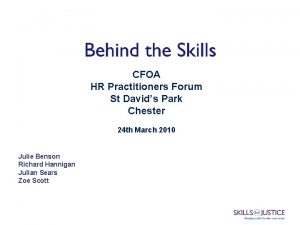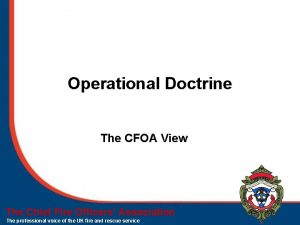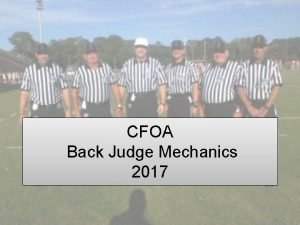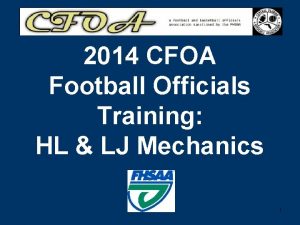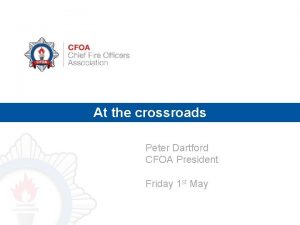CFOA HEALTH AND SAFETY SEMINAR CHILDREN AND YOUNG




































- Slides: 36

CFOA HEALTH AND SAFETY SEMINAR CHILDREN AND YOUNG PEOPLE WORKSHOP Dave Hackney B. Phil Youth Services Manager West Midlands Fire Service

QUOTES OF THE DAY l Ships are safest when they are in port; but that’s not what ships are for – More cyclists drown each year than canoeists - Colin Mortlock l British Canoe Union

QUOTES OF THE DAY A life without adventure is likely to be unsatisfying, but a life in which adventure is allowed to take whatever form it will, is likely to be short. Bertrand Russell

QUOTES OF THE DAY l l Keeping children and young people safe is a top priority. It is the responsibility of us all. But this does not mean that we should wrap children and young people up in cotton wool. Childhood is a time for learning and exploring. Through playing and doing positive activities, children and young people can learn to understand better the opportunities and challenges in the world around them, and how to stay safe. Rt Hon Ed Balls MP, Secretary of State for Children, Schools and Families Staying Safe, A consultation Document

FIRST TASK l l You are the lead instructor of a Young Firefighter Association or Cadet Branch you are planning to take the young people and instructors away camping for a week on a farm in North Wales. Your programme includes canoeing, white water rafting and climbing for which you are using Adventurous Activity Licensing Authority registered centres. You have an instructor who will be responsible for looking after the catering with help from the young people on a rota basis. There are to be 30 young people and seven instructors. Working in groups, your task is to identify the 5 most likely risks for the young people

Task Feedback

Task Feedback I have spent 30 years running camps and residentials with young people. In my experience the most likely risks are: l l l Not eating because don’t like food Sweet and pop induced vomiting Not going to toilet because ‘its not as nice as at home’ Lack of sleep ‘Lost’ personal kit Bad weather Leading to: l Petty arguments l Home sickness

EXAMPLE – ROCK CLIMBING I don’t want to get into the minute detail of risk assessing climbing and abseiling as a physical activity but would like to look at it from a different perspective.

EXAMPLE – ROCK CLIMBING FACTORS Personal Safety Self Esteem Confidence Enjoyment Team building Corporate Security

EXAMPLE – ROCK CLIMBING l Like any other activity success of the rock climbing session lies in the planning and the young people should be involved in the planning from the beginning. l But where is the beginning? l Our role in working with young people includes encouraging them to take part in new experiences – this involves suggestion and encouragement.

WHAT DO YOU WANT FOR BREAKFAST? Working with groups of young people from some of the most deprived areas of Birmingham and planning residentials with them. l Involving them in the planning of the menus l Only ever wanted cereal for breakfast l No expectation of bacon and egg l Absolutely no concept of kedgeree

WHAT DO YOU WANT FOR BREAKFAST? l l Part of the role of youth work is to raise the expectations which young people have of themselves and of others – bacon and egg. Another part is encouraging young people to think ‘outside of the box’ - kedgeree

EXAMPLE – ROCK CLIMBING l l l So if working with a group of young people we have one or two who suggest rock climbing (or we carefully suggest it – ensuring we are not promoting our own favourite activity) - and the majority of the group are up for it, we need to prepare the whole group for the experience, we might: ________________ Lets have some ideas ________

EXAMPLE – ROCK CLIMBING bring in some climbing gear, l let them try on a harness, l teach them a figure of eight loop, l show some photographs l

EXAMPLE – ROCK CLIMBING l l l Alleviate concerns Give more of an idea of what will be expected of them and of the kit they will be using. Improve the whole experience

EXAMPLE – ROCK CLIMBING l The planning and preparation needs to take care of the emotional needs of the young people as well as the organisational, logistics and physical safety.

SO WHATS THIS GOT TO DO WITH US? LIFE - FIRE - PHEONIX - Etc l How often have we heard variations on ‘I aint dressing up like no ‘F*#@+~£’ Fireman Sam l They are less worried about dressing up like fireman Sam and more worried about being taken out of their comfort zone. l Whilst our attention is on the ‘complaining’ individual we are at risk of not keeping control of the whole group l Pre-occupation on what they are looking like will detract from instruction and safety information – increasing risk l If we introduce the kit by showing photographs and/or arranging a pre course fitting session we will alleviate the stress. l A full briefing before the course will go further

ADVENTURE PHILOSOPHY Mortlock's adventure philosophy centres on proposing the existence of four basic "adventure states", which progress in intensity from: l Stage 1: Play: Characterized by little emotion through relatively easy participation in activities l Stage 2: Adventure: (Characterized by enjoyment and excitement, where a person's is l Stage 3: Frontier Adventure: Characterized by peak experience, which emerges l Stage 4: Misadventure: Characterized by a person choosing or being forced to participate which are below the person's skill level using his her capabilities more fully, but the person maintains control over the situation and his/her self from a person experiencing adventurous challenges very close to his/her limits. If the person succeeds, then generally a peak experience is had, but there is real risk of pushing too far and falling/failing, leading to Stage 4. in challenges beyond his/her capabilities, resulting in negative emotions (fear, hurt, etc. ), possibly injury and even ultimately death.

ADVENTURE PHILOSOPHY Priest, S. (1990). The adventure experience paradigm. In J. C. Miles, & S. Priest (Eds. ), Adventure Recreation. (pp. 157 -162). State College PA: Venture Publishing.

RISKS l l l Real Physical Risk – I’m going to get hurt Perceived Physical Risk – I think I will get hurt Emotional Risk – I could loose face Priest, S. (1990).

TASK – DRAW THE LINE l l l Where do we draw the line? How far up and to the left can we let young people go? Where is the most learning occurring Where are people safest Priest, S. (1990).

TASK – DRAW THE LINE l Where do we draw the line – – – A walk in the park A walk to the park An accompanied walk on the South Downs An accompanied walk up Snowdon in Summer An unaccompanied walk up Scafell Pike in Winter with appropriate training An unaccompanied walk up Ben Nevis in Winter without training Priest, S. (1990).

TASK – DRAW THE LINE l l l Where is the most learning occurring If we learn from our mistakes should we always back away from misadventure? Or is misadventure ‘permissible’ so long as it does not move into devastation and disaster Being lost can happen in all segments Being lost on the moors is not a problem for a group which has the right equipment and knows how to use it. With some groups you may hesitate taking them into the local park for game of football Priest, S. (1990).

TASK – DRAW THE LINE l l You can’t The line is in a different place for every individual and for every group To know where to draw the line you need to know your group To know your group you need to be able to build appropriate relationships with the individuals involved

The Purpose Of Youth Work l l l l The occupational standards document identifies one key purpose of youth work: ‘to work with young people to facilitate their personal, social and educational development, and enable them to gain a voice, influence and place in society. ’ They highlight six key aspects that are thought to enable the key purpose, they are summarised as: a) Build relationships with young people. b) Facilitate young people’s learning c) Enable young people to organise and take responsibility for activities d) Work in accordance with core values of youth work e) Plan, manage and develop youth work f) Support and develop effective, efficient and ethical practice National Youth Agency, (2000) National Occupational Standards for Youth Work, Leicester :

The Purpose Of Youth Work a) Build relationships with young people. The layout of these key aspects suggests that the relationships formed are the underpinning factor of any work done. Smith, H. (2002) 'Seeking out the gift of authenticity', l Youth and Policy 77, pp. 19 -32. Also available as an article in the encyclopedia of informal education, l http: //www. infed. org/biblio/authenticity. htm. : l l

THE RISK OF NOT LEARNING l l Back to Rock Climbing Need to involve young people at all stages Doing activities in isolation with the vague hope that ‘something will rub off’ is unprofessional and inefficient and does a disservice to young people – may have just taken them to a theme park. We need to involve young people in the whole process – true participation.

CHRIS AT THE ROCK FACE

CHRIS AT THE ROCK FACE l l l l Looked at the whole rock face Talked about the best route Selected a route Set up safety rope Mates supported and encouraged us Looked at route again Took it one hand/foot hold at a time l l l l Looked at the problem Sort advice Decided on a way to tackle it Got some safety mechanism in place Relied on mates Considered the chosen option Took it one step at a time

CHRIS AT THE ROCK FACE l l l If I had been smarter I would have introduced the concept of problem solving before the climbing session This is known as ‘front loading’ the experience Front loading in one way of improving transfer of learning from one environment to another

WEST MIDLANDS FIRE SERVICE AND PRINCES TRUST TEAMS l Previously 1 member of staff, three teams per year = 45 young people l Now, we deliver fire safety and road safety to around 1000 young people per year in princes Trust Teams across the West Midlands

YOUNGER CHILDREN l LINK

WHATS IT GOT TO DO WITH US?

WHATS IT GOT TO DO WITH US? l l l l l The Fire and Rescue Service Strategy for Children and Young People Our goals are: • To prevent children and young people being harmed or killed in accidental fires or causing fires through ignorance or carelessness. • To prevent children and young people becoming involved in fire crime and associated anti-social behaviour. To achieve these goals we will aim to: • Engage actively with children and young people and their families. • Prevent and reduce fire crime and firesetting by children and young people. • Divert children and young people from fire crime and associated antisocial behaviour. • Educate children and young people and their families in fire safety skills and responsible citizenship. • Ensure that Fire and Rescue Service staff working with children and young people are effective and professional. • Identify and disseminate good practice in working with children and young people.

WHATS IT GOT TO DO WITH US? l l l l Aim 1: Engage actively with children and young people The Fire and Rescue Service recognises the value of listening to young people. Methods: 1. To treat all children and young people with understanding and respect. 2. To develop participation by children and young people, with a focus on those most at risk or most in need. 3. To promote equality and diversity in participation. 4. To involve children and young people in the design, delivery and evaluation of programmes for children and young people. 5. To involve children and young people in developing policy and practice on prevention of accidental fires, fire crime and associated anti-social behaviour at national, regional and local level. 6. To commit to making changes as a result of the involvement of children and young people. 7. To recognise the contribution of children and young people through an annual award.

THE END l P. S. if it was conventional Health and Safety advice for young people on the drill yard, I’m sorry but it can be summed up as: – – – Shorter narrower hose Lighter Branches Shorter ladders Lighter pumps Supervision Expect the unexpected
 Unit 10 caring for children and young people
Unit 10 caring for children and young people Working with young children/answer key chapter 1
Working with young children/answer key chapter 1 Trauma symptom checklist for young children
Trauma symptom checklist for young children Phonemic awareness in young children
Phonemic awareness in young children Sfyc hampshire
Sfyc hampshire Alcohol consumption causes blood vessels to contract
Alcohol consumption causes blood vessels to contract Di sakop ng republic act 10666
Di sakop ng republic act 10666 Cycle safety for children
Cycle safety for children Existanxe
Existanxe National child health program
National child health program Children's mental health
Children's mental health National children's digital health collaborative
National children's digital health collaborative Green paper children's mental health
Green paper children's mental health Catzoc ecdis definition
Catzoc ecdis definition Safety care certification
Safety care certification Process safety vs personal safety
Process safety vs personal safety Ind safety report
Ind safety report Basic safety orientation
Basic safety orientation Basic safety construction site safety orientation
Basic safety construction site safety orientation Health and safety at work act engineering
Health and safety at work act engineering Health and safety regulations in engineering
Health and safety regulations in engineering Health and safety edinburgh
Health and safety edinburgh Objectives of osh
Objectives of osh Care certificate health and safety
Care certificate health and safety Texas health and safety code 343
Texas health and safety code 343 Six pack health and safety regulations
Six pack health and safety regulations Key performance indicator safety kpi template
Key performance indicator safety kpi template Osu ehs training
Osu ehs training Oshax
Oshax Benefits of a safety and health program
Benefits of a safety and health program Health and safety in hrm
Health and safety in hrm Occupational safety and health act 1984
Occupational safety and health act 1984 Occupational health and safety presentation
Occupational health and safety presentation Health and safety act ontario
Health and safety act ontario James gorry health and safety
James gorry health and safety Ipac core competencies
Ipac core competencies Human factor theory
Human factor theory
